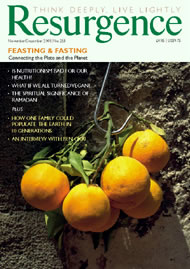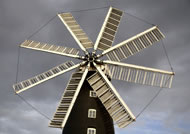OVER THE PAST fifty years, a growing number of traditional wind- and watermills have been restored to full working order to meet the growing demand for high quality local food. The Traditional Cornmillers Guild, established to promote artisan flour-milling by wind or water power, has played a strong role in this renaissance. The Guild celebrates its 21st anniversary in 2008 and currently has some thirty members, who own or manage some of Britain’s most beautiful listed wind- and watermills, dedicated to producing flour of the highest quality using traditional techniques.
They vary in size and type, from small, part-time mills producing a few tonnes a year, to commercial operations milling hundreds of tonnes. They are giving Britain’s old windmills and watermills a new lease of life as the UK looks for ways of addressing climate change, global food shortages and the challenges of peak oil.
So, why is traditional milling better, and how does it differ from modern milling? The key is in the way the grain is ground. The simple grinding of the whole grain in a single pass through and between two horizontal, round millstones is at the heart of traditional milling. It is designed to produce wholemeal flours with excellent flavour and nutritional value. The bottom stone, called the bedstone, is stationary, and the top stone, the runner, rotates. The grain is fed through a hole in the centre of the stone, the eye. It is ground into flour as it takes a few seconds to move outwards between the two stones. Nothing is taken away in the process – whole grain goes in, and wholegrain flour comes out.
And that is the point. In its whole state, grain contains a natural balance of starch, protein, vitamins and fibre. In wheat, many oils and essential B and E vitamins are concentrated in the wheat germ, the life force of the grain. The oily, flavoursome and nutritious wheat germ cannot be separated out in stonegrinding, and it helps to give the flour a characteristic nutty flavour.
In contrast, modern mills are specifically designed to produce white flour. They use a series of high-speed rollers that crush a layer of the whole grain at a time, sieve it off, then remove another layer, and so on. A particle of flour can travel over a mile during this process – passing between rollers and sieves. It enables the wheatgerm and bran to be removed efficiently and has the capacity to produce a vast amount of flour quickly and with minimum human intervention The heat generated in the process of roller-milling can affect nutritional quality, and recent French research has observed sieved stoneground organic flour to have a significantly higher zinc and magnesium content than an equivalent sample of roller-milled non-organic flour. It is possible to produce roller-milled brown flour by re-integrating and mixing the various sieved components, but it is not the same as stoneground wholemeal.
TRADITIONAL MILLS ARE much more than specialist food producers and an important part of Britain’s rural heritage. The majority of the Traditional Cornmillers Guild members are small businesses run by dedicated individuals, families, volunteers, local authorities and charitable trusts. Very often they play an important part in the local community, provide employment, generate sustainable power, preserve old rural crafts and skills, contribute to the tourism economy, and offer an invaluable educational resource including tours, training, and milling, baking and bread-making courses.
Most supply a range of flours and cereal products, often milling to individual needs, for example to meet the growing demand for gluten-free and other specialist flours milled from grains such as spelt.
In the last year or so the Guild has seen a resurgence of interest in specialist, organic and locally grown and milled flours. This is partly the result of increased awareness of how delicious and nutritious proper bread is, thanks to the higher profile of artisan bakers, books about bread, and media coverage.
The development of bread-making machines, the current economic squeeze and the high cost of oil have all helped to raise awareness of how making good bread is good value, good fun and good for you. The work of organisations including the Soil Association, Slow Food UK and Sustain have helped here, as will emerging initiatives like the Slow Bread and the Real Bread campaigns. Long term, the Guild seeks to be an active partner in this vital food chain by continuing to work closely with local farmers, bakers and campaigners to offer a wider range of high-quality, specialist flours. In the meantime, we encourage you to seek out, visit and support your local traditional mill. •







